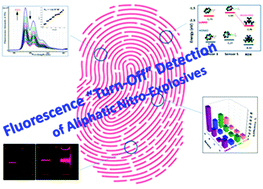1-Hydroxypyrene-based micelle-forming sensors for the visual detection of RDX/TNG/PETN-based bomb plots in water†
Abstract
The high-lying LUMO energy levels of common aliphatic nitro-explosives require special approaches for the proper synthetic design of fluorescence chemosensors that are capable to detect ultra-trace amounts of these explosives via photo-induced electron transfer (PET) fluorescence quenching. Herein, 1-hydroxypyrene has been used as a synthetic platform to prepare a number of water soluble micelle-forming fluorescent chemosensors possessing high-lying LUMO levels. Based on these sensors a cheap and highly efficient method has been described for the detection of low-volatile aliphatic nitro explosives, such as 1,3,5-trinitroperhydro-1,3,5-triazine (RDX), pentaerythritoltetranitrate (PETN), and high volatile taggants/propellants, such as 2,3-dimethyldinitrobutane (DMDNB) or trinitroglycerin (TNG) in aqueous solutions and in vapor phase. The applicability of the sensors for the detection of nitro-explosives was fully confirmed based on the fluorescence quenching titration experiments, with the corresponding Stern–Volmer constants as high as 6.0 × 105 M−1 and the limit of detection (LOD) as low as 12 ppb. The “sphere of action” quenching mechanism has been proposed. To support this, the DFT calculations of the possible molecular complexes between the sensors and nitro-analytes were performed along with the calculations of the quenching sphere radii for the Perrin's model.



 Please wait while we load your content...
Please wait while we load your content...